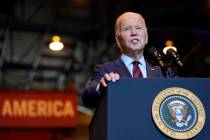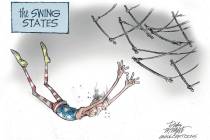Better Budgeting in Carson City
The unveiling of Gov. Brian Sandoval's 2011-13 executive budget was a watershed moment in the history of Silver State finance. His proposal is built around an innovative budgeting method that focuses state spending on ensuring measurable progress toward high-priority policy goals.
Called "performance-based budgeting," the approach is detailed in a new Nevada Policy Research Institute policy study, "Better Budgeting for Better Results." In its best form, the approach enumerates the specific objectives that policymakers would like to achieve through the use of tax dollars, in order of priority. Then it alters the incentive structure within state bureaucracies to reward cost-effective accomplishment of those policy objectives.
This approach recognizes that the means chosen by lawmakers often fail to achieve the desired results. For instance, lawmakers have nearly tripled inflation-adjusted, per-pupil spending on K-12 education over the past 50 years. Yet this spending increase has not translated into anything approaching a proportional increase in student achievement. Indeed, by most metrics the quality of the state's K-12 schools has declined over this period. These trends make it clear that poor policy design has rendered ineffective most K-12 education spending in Nevada.
Performance-based budgeting enables policymakers to overcome these obstacles and achieve their highest goals. It means:
1. Focusing funding on the top priorities.
2. Measuring performance toward the prioritized goals.
3. Incorporating the expertise of state workers, who may well know the most cost-effective means for attaining the sought-after goals.
Practically, this means that once policymakers set the general policy direction, they should provide block grant funding to state agencies and give agency directors discretion over the specific uses of that money -- including the freedom to hire and fire, negotiate wages and purchase needed goods and services.
In return, agency directors would be held to a higher degree of accountability. In Iowa, where this approach has been implemented most aggressively, agency directors operate on short-term contracts with frequent reviews and are responsible for meeting legislatively defined performance metrics -- meaningful measures such as test scores or graduation rates. Agencies that meet or exceed their targets below budget share in the savings -- half of the extra money remains at the agency for employee bonuses or capital improvements and the other half reverts to the state general fund.
In Iowa, this approach has led to dramatic improvements in the quality and availability of state services while simultaneously reducing costs.
For the first time in state history, Sandoval's budget proposal incorporates many of these concepts. His plan would offer block grant funding to school districts and would eliminate onerous requirements for administrators to adhere to costly programs such as class-size reduction, which studies have shown do not enhance student achievement. This would provide competent school district administrators with the flexibility to structure spending in ways that provide the greatest benefit to children.
Concurrently, Sandoval plans to introduce legislation encompassing ideas that have been proved to boost student performance elsewhere without significantly increasing costs. These include: school choice, open enrollment across school districts, identifying and retaining highly effective teachers, and ending social promotion and teacher tenure.
The governor's executive budget also includes several other reforms that closely align spending with achieving desired results. As NPRI has noted, heavily subsidized tuition rates at Nevada's colleges and universities are a poor method for accomplishing lawmakers' goal of increased access for low-income families. Instead, the current system effects a regressive wealth transfer because children from lower-income families are statistically less likely to attend college, despite the fact that those families are forced to pay taxes that subsidize higher education for the wealthy.
Currently, in-state tuition rates in Nevada are nearly half the national average and are far below those of neighboring states, according to data from the U.S. Department of Education. Rather than subsidizing entire institutions, a far better policy would be to allow those institutions to charge tuition rates more closely reflecting market forces while providing need-based financial aid to students whose family income falls below a certain threshold. The Sandoval budget would facilitate a transition to this superior approach.
While Sandoval's first executive budget is not perfect -- it includes several stopgap funding mechanisms akin to mortgaging the future for present spending -- it brings to Silver State governance a type of innovation most Nevadans have long desired, but feared they would never see.
Hats off, governor.
Geoffrey Lawrence is deputy director of policy at the Nevada Policy Research Institute. For more information visit npri.org.























